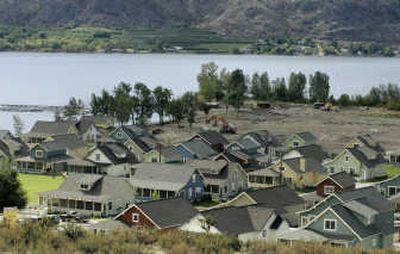Canadians cash in on U.S. property

OROVILLE, Wash. — A string of new, ‘50s-style cottages with cheerfully shaded shingles line the southeast shore of Osoyoos Lake, a long finger lake straddling the U.S.-Canada border in north-central Washington. The vacation village brings to mind nostalgic days of beachside leisure. Even the screen doors slam.
The cottages have all been sold, and more are being built to meet demand from Canadians, who are snapping up vacation homes in the U.S. as Americans watch their wallets and sell their second homes amid a housing crunch.
For Oroville, a sleepy border town that hasn’t experienced growth like this in decades, the development means big changes ahead. Longtime residents wondering what the future holds worry they need only look to Canada’s side of the lake for a clue: crowded condominiums, sprawling resorts and a wine region touted as Canada’s only desert hotspot.
“Probably 80 percent of the inquiries I get are Canadian,” said city planner Chris Branch, who previously split his time between two rural north-central Washington towns but has gone full-time to accommodate Oroville’s growth in the second-home market.
The city has seen an 80 percent increase in construction in the past 10 years. Probably 80 percent of that construction is by Canadian developers, Branch said.
And the developers say upward of 80 percent of the home buyers are Canadian.
“The Canadians are just running out of space, and affordable space at that, so it’s driving them across the border,” he said.
Last fall, the “loonie” reached parity with the U.S. dollar for the first time since 1976. The falling dollar has put all foreign buyers at a significant advantage, giving them a discount of about 30 percent on U.S. property, said Walter Molony, spokesman for the National Association of Realtors. And in terms of vacation property, “sites that are on the water command the best price.”
Even if they are in rural sagebrush with warm days and cool nights.
Oroville started out as a service point for area miners, then evolved into a heavy agriculture town surrounded by acres of apple orchards. Many of those fields have since been pulled out, though, as the apple industry wilted. Six of the 11 fruit warehouses now sit empty.
City officials have been trying to recruit businesses to an industrial park for years, with only limited success. While the population of 1,600 has remained steady for 20 years, it’s likely to decline if more businesses and jobs aren’t drawn to the area, said Chuck Spieth, mayor for eight years.
“It’s not like these are high-paying jobs, but it’s better than nothing. We’ve been stagnant for too long,” he said. “I want to see the growth. I definitely do. We need that to survive. But we need to really step back and make sure it’s for the longer term.”
Not everyone is thrilled to see Oroville become a tourist town. City councilman Jon Neal, born and raised in Oroville, fears local residents will be priced out of their homes.
Property prices around the lake have skyrocketed — from just $200,000 for a single-family home several years ago to $1 million today. Real estate offices are booming.
Osoyoos, Canada’s resort town, also goes from a ghost town in the winter, with about 3,500 year-round residents, to more than 20,000 people in the busy summer season.
“Which is one of the things I don’t want to see Oroville do,” Neal said. “Change is inevitable. It’s the nature of things.
“But you don’t have to like it,” he said with a laugh.
Jim Bankson, who handles rental sales for the new resort Veranda Beach, said he doesn’t hear much resistance, thanks to the windfall many residents saw by selling property.
“The tourism industry is the one saving grace for Oroville,” Bankson said. “It’s pretty much been proven that people are pulling out orchards because they can’t make money growing apples here.”
And despite the detractors, he said, some residents have seen opportunity in the growth.
One man started a landscaping company and has garnered the resort’s business. In town, some women started a grocery shopping service, stocking cupboards and refrigerators for vacationers who are renting houses for only a week or two.
The lone remaining apple co-op that entered the wine business in 2000, hoping to capitalize on the 50-plus wineries in Canada’s Okanagan Valley just 5 miles to the north, now enjoys competition on the U.S. side. Recently, three new wineries opened.
“We’d love to see more wineries. Who wants to drive all this way for one tasting?” said Mike Buckmiller, winemaker for Okanogan Estate and Vineyards. Acidity in the region’s soil, so perfect for tomatoes grown for a local canning plant decades ago, also lends itself well to wine grapes, Buckmiller said. And even as local grape growers experiment with new varieties, wineries to the north haven’t been shy to share advice.
“They were wide open with information and how to get it. My hat’s off to them, because they never tried to keep anything under their belts,” he said. “And I don’t think there’s anything wrong with riding on their shirttails.”
Spieth, the mayor, said the trick will be attracting businesses and jobs that last year-round, not just in the warm summer months.
“It’s an exciting time for our little area,” he said. “We share the same lake, the same opportunities, the same climate. We should benefit, too.
As to whether Oroville wants to be a tourist town, he said, “I don’t think we have a choice at this point.”